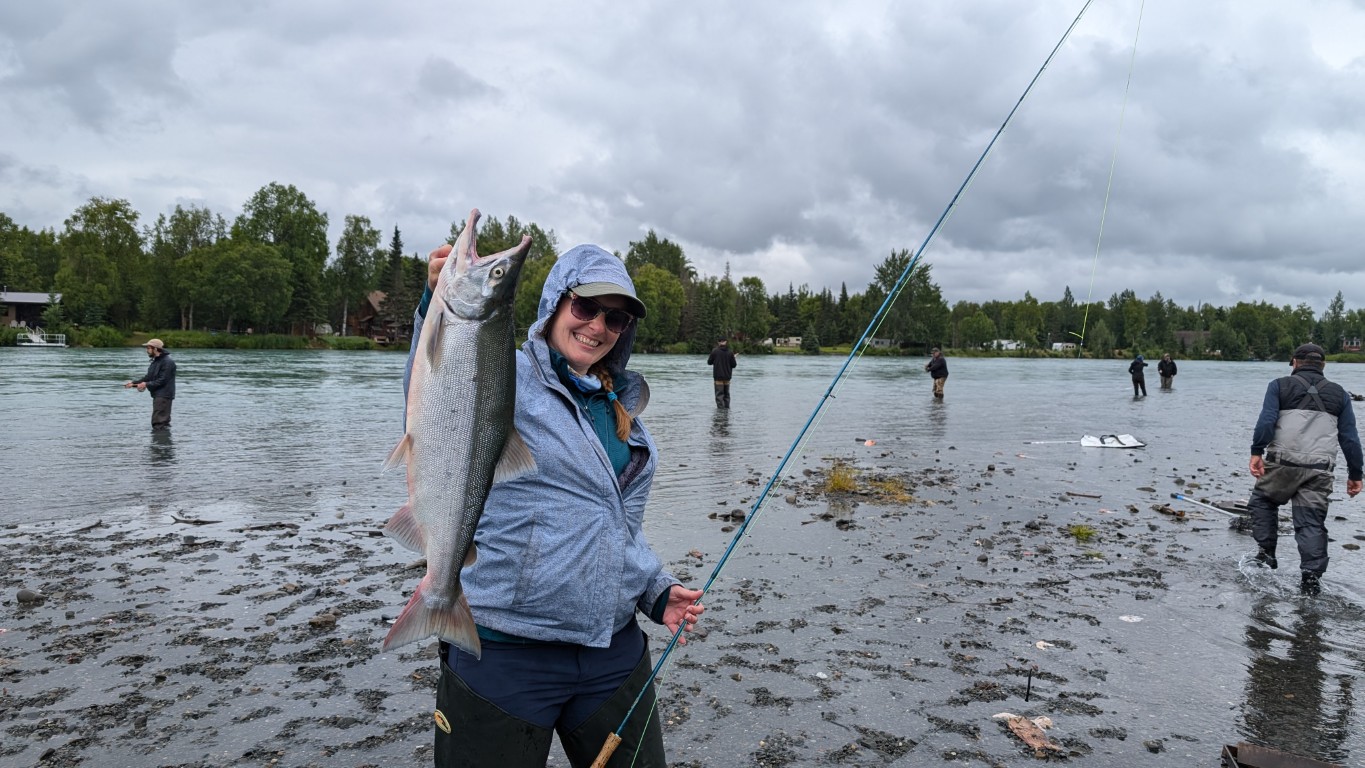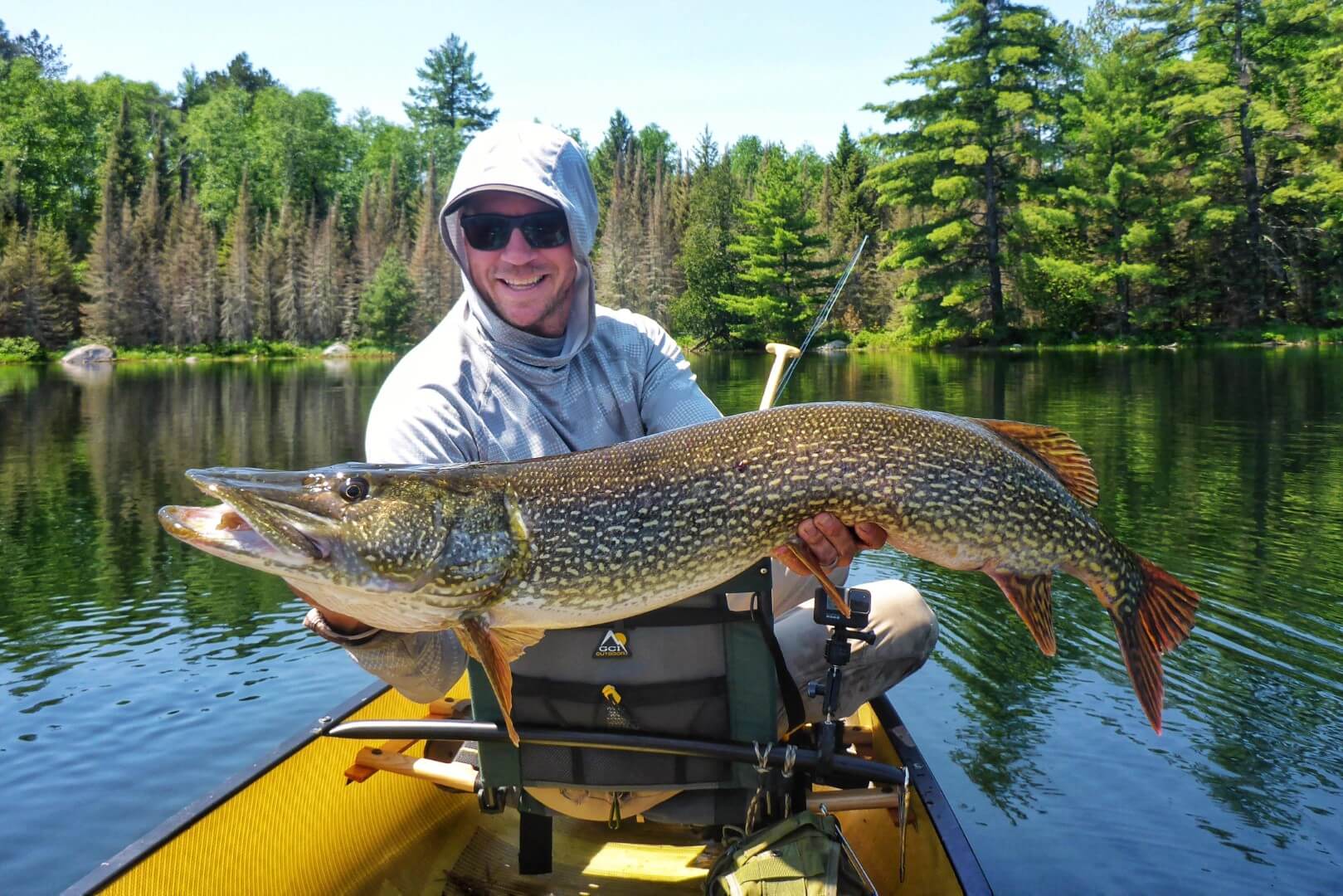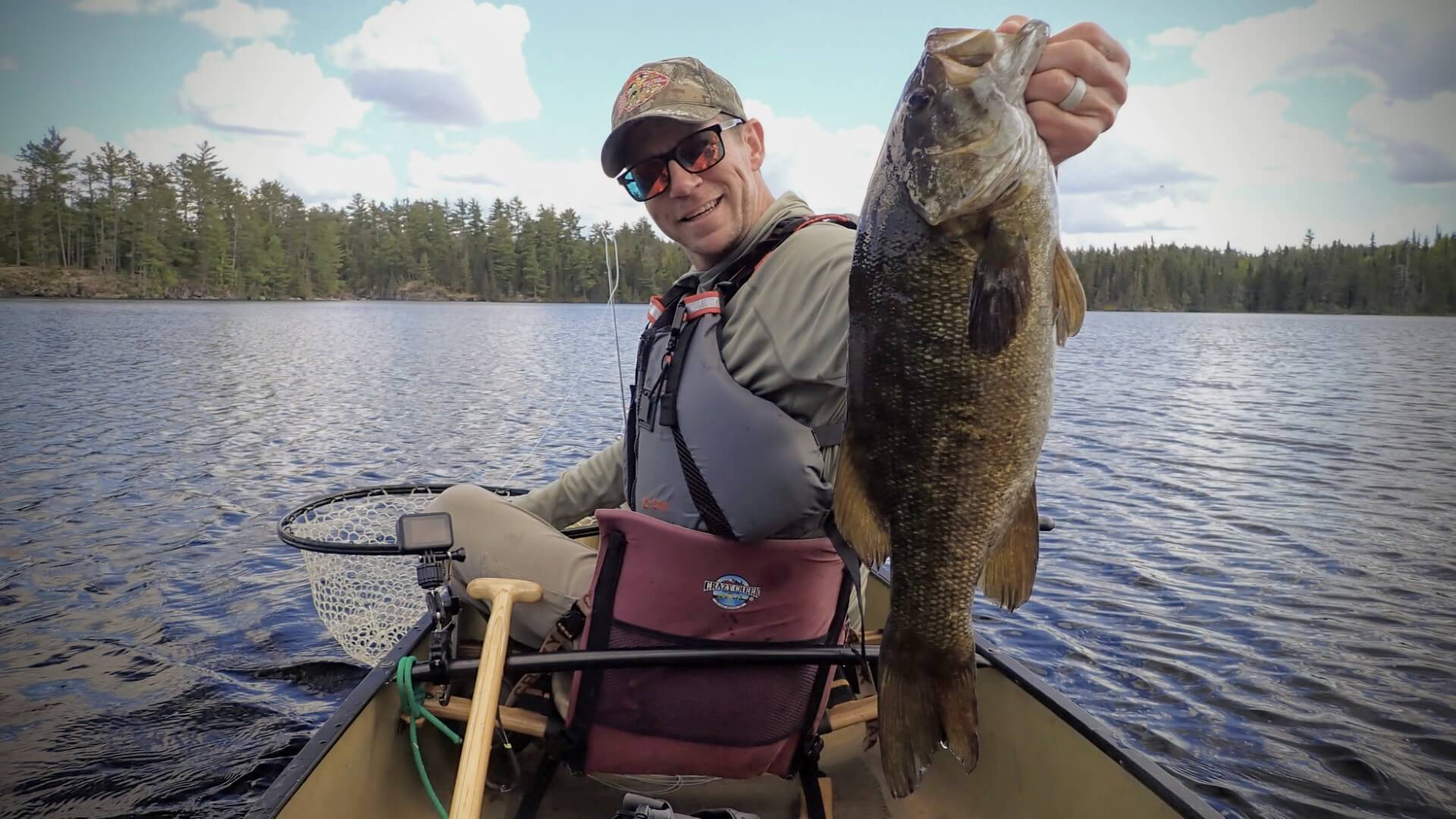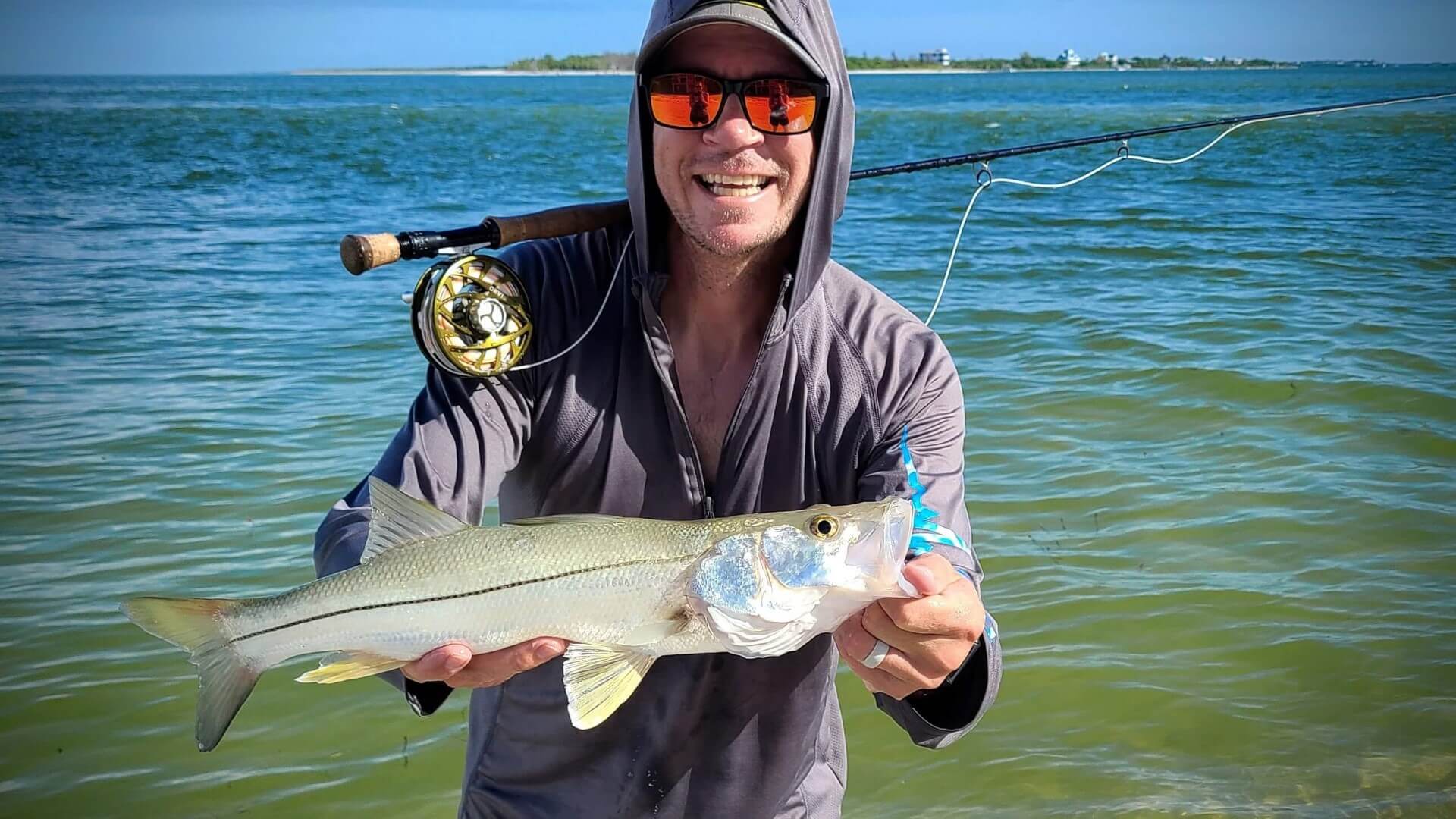The Gear You Need To Swing For Great Lakes Steelhead
If you do a search for the perfect swinging rod or swinging gear you’ll most likely find a bunch of information about fishing big west coast rivers. A rod that works out there can work in the Great Lakes area, but it may not be the best solution. Rivers in the Midwest, like the Bois Brule in Northern Wisconsin and tributaries on the North Shore of Lake Superior are not as big, don’t have as high of flows, and the fish generally aren’t as big as on the west coast. This means that you will be able to use shorter two-handed rods and lighter lines to swing. Instead of going over every option of rod, reel, and shooting head setup, I will cover the most common setups used in the Great Lakes tributaries and let you custom fit your setup for how you like to fish. Make sure you have the rest of the essential fly fishing gear for great lakes steelhead before we cover the gear you will need to dive into the swinging game.
It can be extremely confusing trying to rig up a swinging rod. The length, power, and extra handle of two-handed rods complicate the proprietary weight system, so you can no longer simply pair an 8wt line to an 8wt rod. Instead of weight shooting head systems are measured in grains. So we are no longer talking about an imaginary weight, but instead talking actual grain weight of a shooting head and sink-tip. If that isn’t confusing enough you also need to decide what strength running line to use, what types of sink tips you should have, as well as the vast assortment of flies to use.
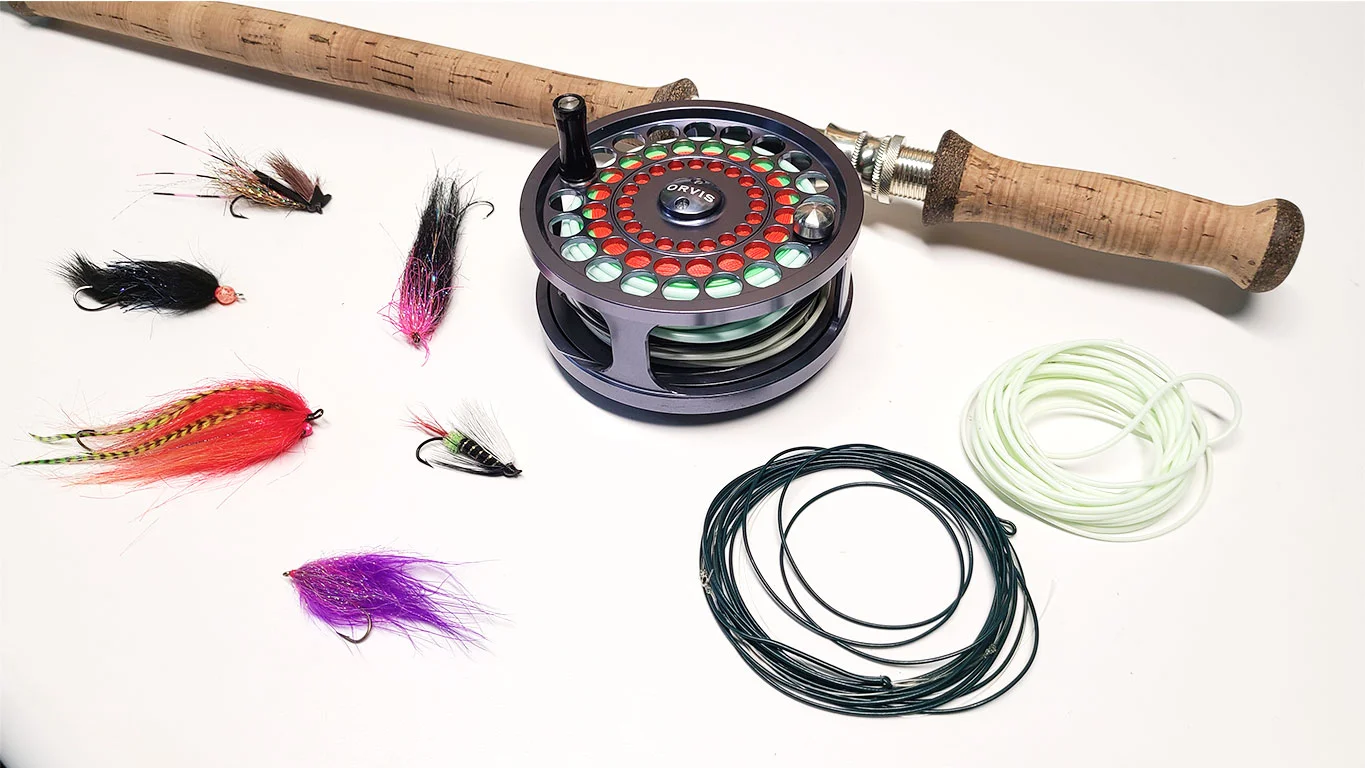
Don’t worry though, I’m here to try and sort through all the new jargon, explain how to build your perfect swinging setup, and get you out on the water and hooked up to a giant steelhead! I have a couple examples below with a complete list of my current setup, and my recommendation for the perfect budget setup.
The 8 pieces of gear you will need to swing.
Other than the basic steelhead gear you should have, this is everything you need to get started swinging flies for steelhead. If you are interested in a specific section, just click the topic and it will jump to that section.
- Rod ↴
- Reel ↴
- Backing ↴
- Running Line ↴
- Shooting Head ↴
- Sink Tips ↴
- Leader ↴
- Flies ↴
Rod
You can use nearly any type of fly rod to swing. Single-handed or two-handed, 9ft or 13ft. They will all work, but if you are going to primarily swing for Great Lakes migratory fish you will want an 11ft 7wt two-handed switch rod (a two-handed rod that allows for spey casting as well as overhand casting). A 7wt will allow you to throw nearly any size streamer and should handle any anadromous fish in the Midwest (except for maybe a king). 11ft is the sweet spot for rod length. The longer your rod the less effort you will need to put into your casts, but going too long can hinder fishing in tighter quarters.
So if you are just getting started, get what is proven to work in 95% of the Great Lakes tributaries, the 30-06 of switch rods, an 11’ 7wt.
Here are a couple of great switch rod options:
- Budget Options (under $300): Redington Dually, Echo Swing
- Midrange Options($300 - $550): Redington Chromer, Echo Compact Spey, Loop Evotec, TFO Axiom 2 Switch
- High-End Option ($550 and over): Sage X Switch
Reel
The most important factors when picking out a reel are weight, line capacity, and a reel with a fully enclosed spool.
Weight
You don’t need to skimp on weight, and I don’t necessarily mean weight as in the size of real (7-9wt) but in the actual weight of the reel. Often a reel on the heavier side will balance out your 11’ rod better than a lighter one. It can be tiring and out-right frustrating to hold the end of your rod tip up all day long. Each rod balances differently though, and a rod with a down-locking reel seat will often balance better with a lighter reel than one with an up-locking reel seat and longer bottom handle. Get a reel on the higher end of your rod. If you have a 7wt switch rod get at least a 7wt reel, possibly going up to 9 or 10wt reel will help balance your rod.
Arbor Size
Mid-arbor reels are ideal for shooting head style line setups. They allow you to add a decent amount of backing behind your running line, shooting head, sink tips, and leader, while still allowing for somewhat quick line retrieval.
Enclosed Spool
Running line is much smaller in diameter than your typical fly line. Having an enclosed spool will keep your running line from passing in between your reel and spool which can cause your running line to kink and weaken or, even worse, get stuck while you are fighting a fish. Spey reels are always built this way, but you can pick up a standard fly reel with an enclosed spool for not much more than a standard reel. Each of the following reels are fully enclosed except for the Budget options. Enclosed reels are not a deal-breaker, but will give you a little extra peace-of-mind.
Click and Pawl Reels
Many spey reels are built with a click-and-pawl and do not have a drag system (like the Orvis Battenkill). There is no advantage to these reels except they are louder, “objectively cooler”, and more exciting when you catch a fish and have to worry about palming the reel to create drag. They are great options, but if you are new to swinging it is better to stick with a reel with an actual working drag system.
- Budget Options (under $150): Redington Behemoth, Echo Bravo
- Midrange Options ($150 - $250): Loop Q, Lamson Liquid HD, Orvis Battenkill
- High-End Option ($250 and over): Sage Spey
Backing
Your standard 20 or 30 lb backing will work just fine. Just make sure you use backing that is heavier than the heaviest leader you think you’ll ever use. If you are going to fish for king salmon and may tie on a 20 lb leader you should have backing that is at least 20 lbs. Fill your reel up with at least 100 yds of backing but add more to make sure your spool is full when the rest of your shooting head system is tied on. If a fish takes you over 100 yards into your backing, you have more problems than simply running out of backing.
- Budget Option: Backing
- Midrange Option: Rio Backing
Running Line
Instead of a weight forward fly line that has a skinnier back end to allow the line to shoot out of your rod, a shooting head system is broken into separate parts: the shooting head is the weight forward part of your line and the running line takes the place of the skinnier section of fly line that you hold onto. The skinnier running line is what allows the shooting head to, well… shoot out of the fly rod and across the river.
There is some give and take when it comes to running line. The skinnier the line the further you can cast, but it also makes it difficult to hold onto in the cold months when you will be using it. Vice-versa a thicker line is easier to handle, but will not allow for casting quite as far. You don’t want to go too light however because most importantly you do not want to break your running line (especially if there is a fish on the other end) and also having thicker line causes drag on your guides as you cast and will help to straighten out your shooting head at the end of your cast. Having too light of running line will allow you to cast further, but your shooting head will land in a clump. Generally 30-50 lb running line is used for the majority of setups in the great lakes.
OPST’s Lazer line is more expensive than regular mono (which you can use), but it will last for years, shoots well, and doesn’t tangle.
You should spool up at least 30-40 yards of shooting line on your reel.
- Budget Option: Berkley Big Game
- Midrange Option: OPST Lazer Line
Shooting Head
There are two general categories of shooting heads, scandi and skagit. As great lakes steelheaders, we are more interested in the later. Although somewhat similar in idea, scandi and skagit vary greatly in use, techniques, and applications. Here is a great video on Understanding the Difference Between Skagit & Scandi Lines by the Ashland Fly Shop. Since Skagit is the more popular version the rest of my gear recommendations will be based on a skagit style head.
Scandi
Scandi heads are meant more for the tributaries in Scandinavia where there are fewer trees, the water is much wider, shallower, and often clearer. Scandi heads are much longer (30ft-40ft) and typically used with long 13 to 15 ft (or longer) spey rods. A cast known as a “touch and go” cast allows for extreme distances, but the long skinnier head doesn’t allow for sink tips or large flies which are often used when fishing the Great Lakes tributaries.
Skagit
Skagit heads are ideal for fishing migratory steelhead and browns in the Midwest. Skagit heads are far more compact (15ft-25ft). Compared to scandi heads, they are easier to cast (using water loaded casts I will cover in a future article), and will allow you to throw heavy sink tips as well as large flies.
There are many different brands of skagit heads these days, each with their own pros and cons. One of the most popular brands is the OPST Commando head. If you want to go a little deeper into the differences in skagit heads there is a great article explaining skagit heads by Hatch Magazine.
- Budget Option (under $20): Aventik Shooting Head
- Midrange Options ($50 - $60): OPST Commando Head, Airflo Skagit Scout, Orvis Mission Skagit
- Scandi Options ($50 - $60): Scientific Anglers Scandi, Airflo Scandi Long
The most important factor to consider when getting a shooting head is matching it up with your rod. You need to have the right amount of weight to load the rod and turn that energy into a forward cast. If you are using an 11’ 7wt rod, depending on the action and power of the rod, a head with a grain weight anywhere between 350 and 400 grains should work. OPST is extremely helpful at getting you the right grain weight head for your rod.
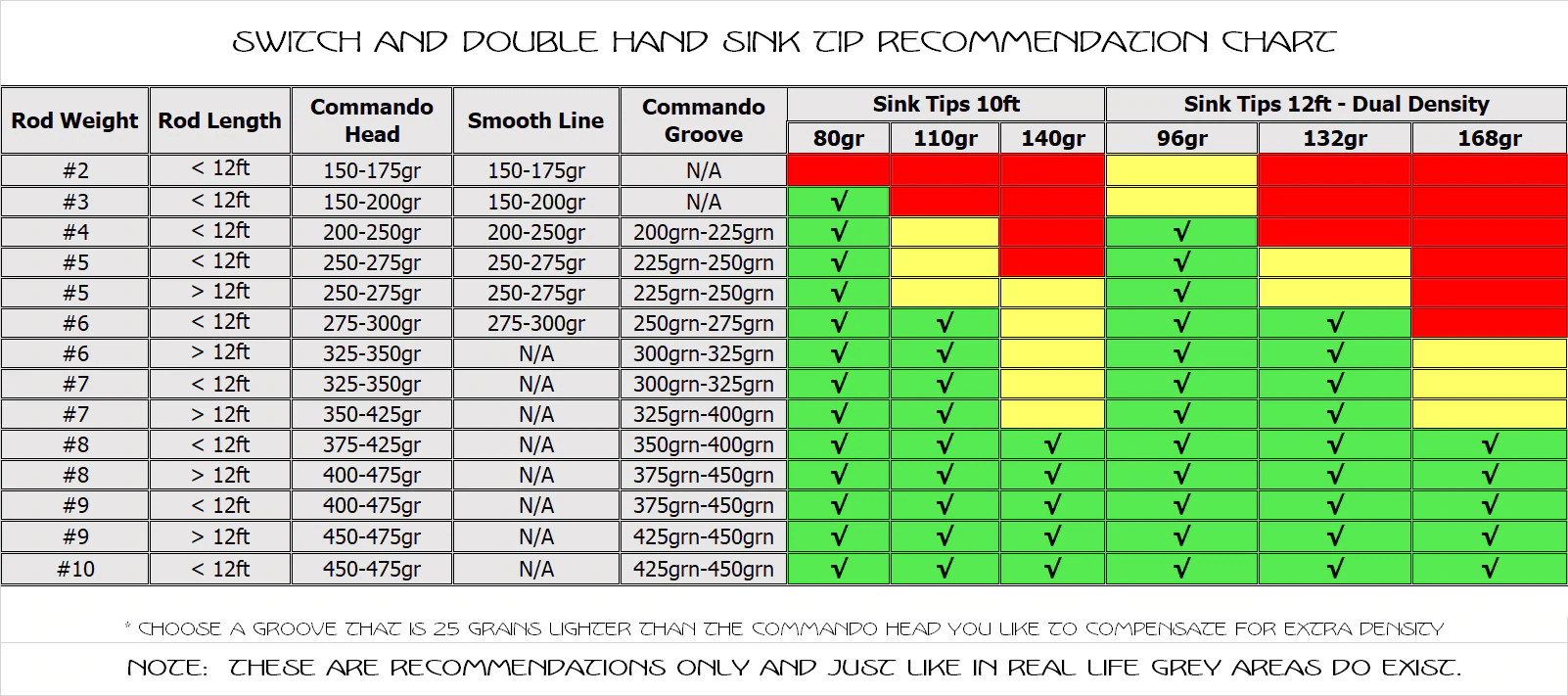
Sink Tips
Skagit heads aren’t meant to have a leader tied directly to them. No matter what skagit head you buy, you will need to add a tip to the front of it. There are a handful of different brands you can choose from, but the best options are from Rio and OPST.
You can buy a larger section of T8, T11, or T14 and build your own sink tips by cutting down to length. This is the cheapest option, but you will need to be able to tie your own loops at the end of each tip.
- Midrange Options ($25/tip): OPST Sink Tips, Rio Sink Tips, Rio’s iMow Tip Kit (6 tips)
Rio’s Mow tips are all 10’ in length with different lengths of sinking line integrated into the tip. They also make iMow tips that start with an intermediate section instead of floating and have also recently come out with a multi-density tip with three different sink rates built into each tip.
I would recommend getting at least two tips when starting out. Either a Run and Bucket from OPST, or a 5’float/5’sink and 10’sink from Rio.
10’ PolyLeaders and VersiLeaders can also work, but are better suited for lighter fishing applications.
Leader
Your leader may change depending on water clarity and what type of sink tip you are using. However, the majority of the time you will want a 3-5ft section of 10-15lb monofilament. If you are fishing heavier sink tips a shorter leader will keep your fly down, but if you are fishing shallower runs with a lighter sink tip or the water is extremely clear you will want to tie on a longer and lighter leader. You don’t need to overthink it too much. Just pick up a mini spool of Maxima Ultragreen in 12 lb test, and you will be covered for most situations. Since the fish usually come up from behind a swung fly you don’t need to worry as much about using up your expensive fluorocarbon line. Using monofilament for a leader can be beneficial since the vicious strikes can be somewhat absorbed by a leader with a little more stretch like a mono leader.
Flies
Sorry, there aren’t going be a ton of secrets divulged here. This may seem like a generic statement to keep my favorite flies to myself, but honestly, the best fly you can use it the one you have the most confidence in. I understand that it can be difficult if you are just starting out, but you don’t necessarily have to get started filling up a new box full of swinging flies. Although after you start swinging, filling a box or two with swinging flies is the next natural step (and part of the fun).
It is a good idea to start out with a fly that you can cast. You aren’t going to catch a fish if the fly you have is too heavy or bulky to cast effectively. Start with a woolly bugger, slumpbuster, muddler minnow, or egg-sucking leach. It can be easy to get caught up in the hype that swinging flies automatically means you need to tie on a giant intruder, but using smaller flies will make it easier to catch more fish, and eventually, you can start experimenting with bigger and more intricate intruders.
For choosing colors, the basics apply to any type of fishing. On dark days or in dirty water use a darker fly, and on a bright day or in clear water use a brighter, more natural fly. Eventually, you will find flies that work for you and give you confidence.
Yes, certain patterns will outfish others, but they can change day to day, and none of that is important if you aren’t getting your fly in front of a fish and presenting it in a way that entices a fish to eat it.
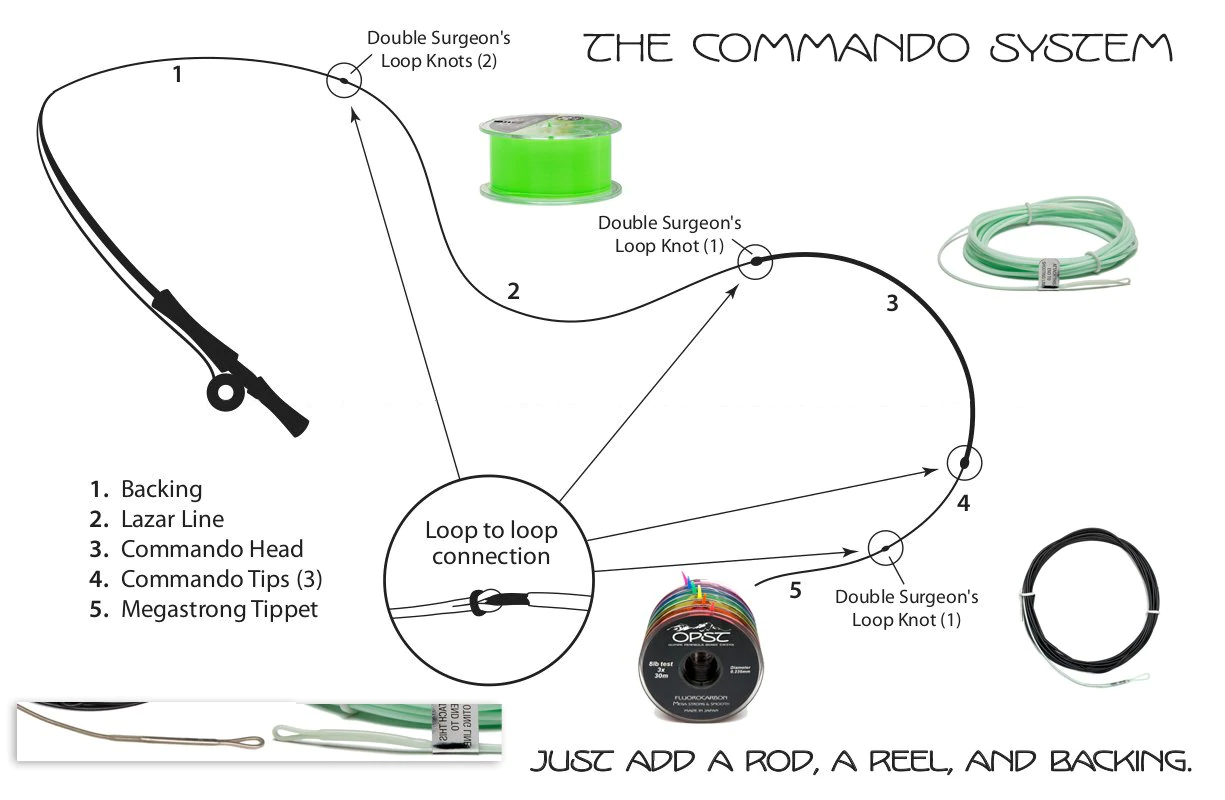
My Current Swinging Setup

- Rod: Redington Chromer (7wt 11.5’)
- Reel: Redington Behemoth (7/8wt)
- Backing: Fly Line Backing (30lb)
- Running Line: OPST Lazer Line (40lb)
- Shooting Head: OPST Commando Head (375 grain)
- Sink Tips: Rio Sink Tips (Medium 10’ float, Medium 5’float/5’sink, Medium 10’ sink)
- Leader: Maxima Ultragreen (25lb and 12lb)
- Flies: carpet spider, intruder, hobo spey, bad hair day, eat-a-peach, popsicle, muddler, wooly bugger, egg-sucking leach, muddy buddy, slumpbuster
Total Cost: $600 - $700 (don’t tell my wife)
Best Budget Setup
- Rod: Redington Dually (7wt 11.5’)
- Reel: Redington Behemoth (7/8wt)
- Backing: Fly Line Backing (30lb)
- Running Line: Berkley Big Game (40lb)
- Shooting Head: OPST Commando Head (375 grain)
- Sink Tips: Rio Sink Tips Medium (2.5’float/7.5’sink)
- Leader: Maxima Ultragreen (25lb and 12lb)
Total Cost: $400 - $500
Best Budget Setup (single-handed version)
If you are not going to swing all the time or even if you want to swing for trout and smallmouth bass, you can easily get into swinging with OPST’s new Commando Smooth line and a couple of sink tips. It’s not as easy to spey cast with a single-handed rod, but can be a great option to get into swinging without a large investment.
- Rod: Your single-handed fly rod
- Reel: Your current reel
- Backing: Your current backing
- Running Line: Berkley Big Game (40lb)
- Shooting Head: OPST Commando Head (375 grain)
- Sink Tips: OPST Pure Skagit Commando Tip
- Leader: Maxima Ultragreen (25lb and 12lb)
Total Cost: less than $100
That’s it for the gear, but stay tuned! There is still another article coming up on spey casts you should learn first as well as tips on fishing the right water, and how to get your fly in front of fish. If you want to be notified when those articles come out you can subscribe to my newsletter, follow me on Facebook, or follow me on Instagram.
If you found this article helpful, please consider sharing!
js-outdoors is a free resource for all anglers.
Please consinder donating to keep this site ad-free!


![How To Tie An Intruder [video]](/images/how-to-tie-an-intruder.jpg)
![Steelhead In The Snow [video]](/images/steelhead-in-the-snow.jpg)
